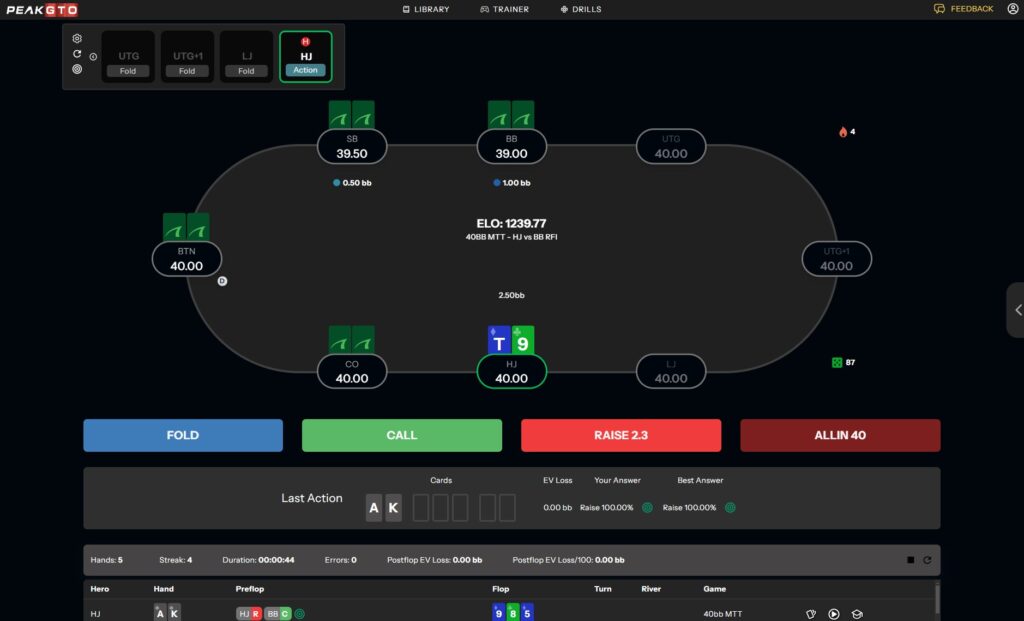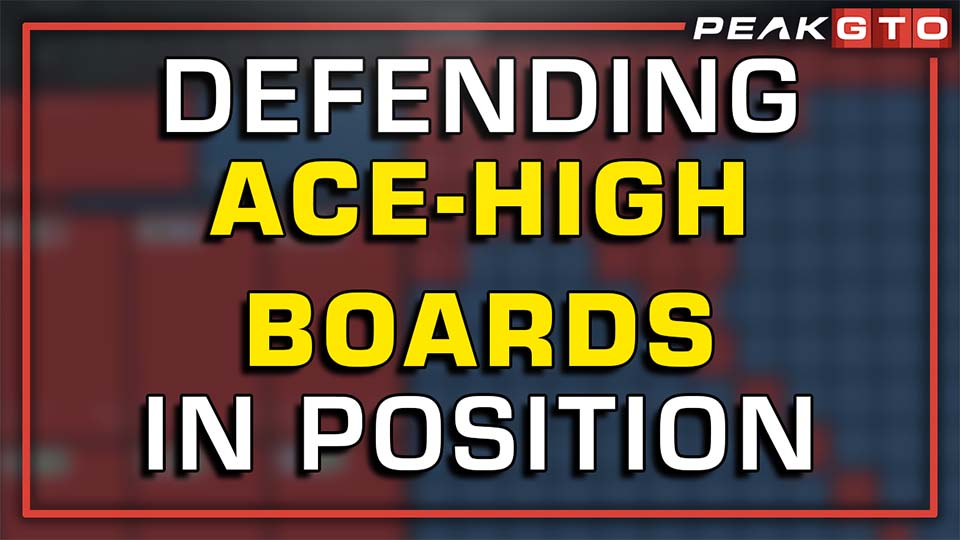In tournament poker, mastering preflop tournament fundamentals is key to success. While postflop decisions often get more attention, your preflop choices set the stage for every hand, shaping your chances of going deep.
This blog explores how variables like position, stacks, and ICM impact preflop strategy. We’ll highlight how to adjust your play and discuss the value of studying tournament scenarios with PeakGTO to build a solid preflop foundation. By refining these fundamentals, you’ll gain a strategic edge at the table.
Position: The Foundation of Preflop Strategy

One of the most crucial factors in preflop tournament play is your poker position. Where you sit at the table influences how many players you have to act against postflop, and your position significantly impacts the range of hands you can profitably open with. As a rule of thumb, the earlier your position, the tighter your opening range should be. The closer you get to the Button, the more flexible and aggressive your range can become.
Early Position (EP)
Players in early positions (like UTG or UTG+1) face the biggest challenge preflop. With many players still left to act, opening with weaker hands can leave you vulnerable to 3-bets and/or difficult postflop decisions when out of position. Therefore, your range from early position should be strong and linear. The goal here is to avoid tough spots postflop by sticking to hands that can perform well even if facing multiple opponents.
Middle Position (MP)
In middle position, you gain a slight advantage as fewer players remain to act after you. Here, you can start to expand your range slightly, incorporating more suited connectors and medium pocket pairs. While you still need to be cautious, the added benefit of having fewer players left to act allows for a wider range that can handle both aggressive and passive table dynamics.
Late Position (CO and BTN)
Late position, especially the Button (BTN), is where you gain the most flexibility in your preflop play. With only the blinds left to act, you can open a much wider range of hands, including speculative hands like low suited connectors and weaker high-card hands. From these positions, you have the advantage of acting last postflop, giving you more information and control over the hand. This positional advantage allows you to apply pressure, steal blinds, and make decisions with more clarity.
Blinds (SB and BB)
When in the blinds, you’re in a tough spot because you’ll be out of position for the rest of the hand. In the small blind (SB), your range should be more polarized—either strong hands or hands that play well in 3-bet pots. The big blind (BB) allows for a wider defending range due to the pot odds, but you still need to be cautious of raising ranges, especially from late position.
Position is the most fundamental variable that influences preflop strategy. As your position improves, your range can widen, allowing for more aggressive and speculative play, while earlier positions demand a tight, strong range to avoid difficult postflop situations.
Effective Stack Sizes: The Driving Force Behind Range Adjustments

Whether you’re playing Texas Hold’em, Pot Limit Omaha, or any other big bet poker variant, effective stack size is a key factor that influences your preflop decisions in tournament poker. As your stack size changes, so too should your preflop ranges. The deeper you are, the more speculative hands you can play, while shorter stacks require you to focus on hands with immediate value. In tournaments, where chip preservation and maximizing equity are essential, adjusting your preflop ranges based on your stack size is crucial for survival and success.
Deep Stacks (60+ Big Blinds)
With a deep stack, you have the flexibility to play a wider range of hands, including speculative ones like suited connectors and small pairs. These hands can profit from implied odds, meaning the potential to win big pots postflop compensates for the risk of playing them. In deep-stack situations, you can afford to take more risks preflop because you have the chips to navigate tricky postflop scenarios. However, balance is key—you don’t want to overplay marginal hands just because you have a larger stack.
Medium Stacks (25-60 Big Blinds)
When your stack size is in the medium range, your preflop play becomes more conservative. Here, you need to be more selective with your opening hands, as you don’t have the luxury of deep-stack maneuverability. In this range, it’s crucial to focus on hands that can either win immediately or hold strong equity against opponents’ ranges. Position and your opponents’ tendencies should also factor into how wide you open, but generally, medium stacks require tightening your range compared to deep-stack play.
Short Stacks (25 Big Blinds or Less)
When playing with a short stack, your preflop strategy shifts to survival mode. Here, you need to prioritize hands that can win right away or give you a solid chance in a push-fold situation. At this stage, hands with strong immediate equity, such as high pairs, strong Broadway hands, and suited aces, take precedence over speculative hands. Your goal is to either steal blinds with well-timed aggression or get your chips in with a hand that performs well against a range of callers. Marginal hands become unplayable as you focus on preserving your stack and maximizing fold equity when possible.
Effective Stack Considerations
Remember that “effective stacks” refer to the smallest stack between you and your opponents in a hand. If you’re deep-stacked but your opponent is short, their stack size should dictate your decision-making. Against short stacks, you might opt for tighter raises to avoid risking large portions of your stack against an all-in shove. Conversely, when you are the short stack, your preflop strategy revolves around finding high-equity hands to maximize your chances of doubling up.
Your effective stack size has a direct impact on your preflop range. Deep stacks allow for a wider range, while medium stacks require tighter, more cautious openings. Short stacks force you to prioritize survival, focusing on hands with strong immediate equity. Adjusting your strategy based on your stack is essential for long-term tournament success.
Stage of the Tournament: Early, Middle, and Late Game Dynamics

As a tournament progresses, the dynamics of preflop play and your overall poker strategy change significantly. The decisions you make in the early stages, when stacks are deep and the risk is relatively low, differ from the adjustments needed in the middle stages when the field is shrinking and stack sizes vary widely. By the late stages, ICM pressure and pay jumps further complicate preflop strategy, requiring tighter play and a greater emphasis on survival. Understanding how the stage of the tournament impacts preflop decisions is key to staying competitive and maximizing your chip stack.
Early Stages: Playing Deep-Stacked
In the early stages of a tournament, most players have deep stacks relative to the blinds, giving you more room for postflop play. Here, the focus is on chip accumulation rather than survival, which means you can open with a wider range of hands, especially in position. Suited connectors, small pairs, and speculative hands are more valuable at this stage because of their potential to win big pots. However, it’s still important to avoid over-committing chips with marginal hands, particularly from early positions, as there is little ICM pressure and the focus is on building your stack.
Middle Stages: Adjusting for Varying Stack Sizes
As you transition into the middle stages of a tournament, effective stacks begin to vary widely. You’ll encounter short stacks looking to double up and larger stacks applying pressure to pick up blinds and antes. This phase requires more selective preflop play, as the risks of losing significant portions of your stack increase. Mid-stage tournament play often involves balancing between exploiting weaker players and avoiding risky confrontations with bigger stacks.
Additionally, ICM considerations start to come into play, especially near the bubble. Players tend to tighten up as they approach significant pay jumps, so aggressive preflop steals and well-timed 3-bets can be highly profitable against cautious opponents. However, you must be aware of your own stack size relative to the field to avoid unnecessary risk.
Late Stages: ICM Pressure Dominates
In the late stages, particularly when you’re nearing the final table or deep into the money, ICM pressure becomes a critical factor. ICM poker (Independent Chip Model) calculations take into account the value of each chip based on remaining pay jumps, forcing players to consider risk more carefully. Preflop ranges tighten significantly as every decision could mean a major shift in prize equity.
At this point, playing too wide preflop can lead to disaster, as losing even a small portion of your stack can cripple your chances of moving up in payouts. Short stacks often shift into push-fold mode, while larger stacks can apply pressure, particularly on medium stacks trying to survive. This is where understanding ICM dynamics helps you balance between maximizing chip accumulation and avoiding unnecessary all-ins or marginal plays.
The stage of the tournament significantly impacts your preflop decisions. Early on, chip accumulation with wider ranges is the focus, while the middle
The Role of PeakGTO in Mastering Tournament Preflop Strategy
Preflop tournament strategy can be highly nuanced, requiring constant adjustments based on position, stack sizes, and tournament dynamics. While experience and intuition can guide some of these decisions, studying and practicing with tools like PeakGTO can provide a significant edge. PeakGTO is a powerful tool that allows players to explore GTO poker (Game Theory Optimal) solutions in various tournament scenarios, helping to build a deeper understanding of preflop ranges and how to adjust them according to different factors.

Try PeakGTO now and up your game!
Efficient Study and Practice
PeakGTO provides simulations of tournament situations, allowing players to practice preflop scenarios repeatedly. Whether you’re in early position with a deep stack or nearing the final table with short stacks and ICM pressure, the tool generates GTO-based recommendations for your opening ranges. By studying these scenarios, you develop an intuitive understanding of how your ranges should evolve throughout a tournament, ensuring that you’re prepared to make optimal preflop decisions in real time.
Adapting to Stack Sizes and Tournament Stages
One of PeakGTO’s greatest strengths is its ability to model how preflop ranges change as stack sizes shrink and ICM becomes more relevant. It can simulate various stack depths—from deep-stacked play in the early stages to short-stacked push-fold decisions in the late game. This allows players to practice the nuances of adjusting their ranges based on stack size and tournament stage, avoiding common mistakes such as overplaying speculative hands when short-stacked or missing valuable push opportunities when ICM is in play.
Balancing GTO with Exploitative Adjustments
While GTO solutions form a solid foundation, they are designed to be unexploitable in the long run, meaning they don’t account for specific opponent tendencies. PeakGTO helps players strike the right balance between GTO fundamentals and exploitative play. By studying GTO ranges, you ensure that your baseline preflop strategy is sound, minimizing the risk of being exploited by skilled opponents. However, in live tournaments or softer fields, you can deviate from these strategies to exploit specific player tendencies, such as overly tight play on the bubble or frequent aggression from loose opponents.
Building Confidence and Consistency
Preflop tournament play can be stressful, especially in high-pressure situations like deep runs or final tables. Using PeakGTO to simulate these situations before they arise allows you to build confidence in your decision-making process. When you’re familiar with the optimal poker ranges for different stages of the tournament, you can make preflop decisions more quickly and consistently, reducing the chance of costly mistakes. This preparation translates into better focus and performance when it counts the most.





